Excerpts from Jim Conrad's
Naturalist Newsletter
from the February 21, 2016 Newsletter issued from Hacienda Chichen Resort beside Chichén Itzá Ruins; limestone bedrock; elevation ~39m (~128ft), N20.675°, W88.569°; central Yucatán state, MÉXICO
ÁRNICA BUSH
In Mexico the name ÁRNICA is applied to several large, yellow-flowered members of the Sunflower or Composite Family. Locally the name is used mostly for what English speakers sometimes call the Giant Mexican Sunflower, Tithonia diversifolia, shown at www.backyardnature.net/yucatan/tithonia.htm.
I'm thinking about the name Árnica now because this week a yellow-flowered member of the Sunflower Family turned up still blossoming despite the lack of rain for several weeks, and the Maya often call it Árnica-che, the word "che" usually meaning bush. So, this week's plant was the "Árnica Bush," a name possibly appearing in print here for the first time. But, what was this Árnica-che in terms the outside world can understand?
It was a branching, head-high, woody bush whose spineless stems arched like those of blackberry canes, and forming a blackberry-bramble-like thicket in a small, partly shaded clearing in the woods that had been abandoned for several years. Below, you can see the bush's rough, veiny leaves, two per stem node, and some branch-end flower-clusters:
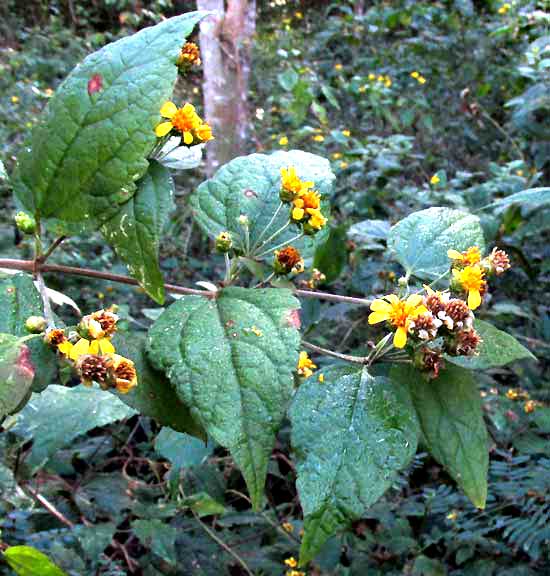
Two peculiarities about the plant visible in that photo are that each flower cluster consists of several heads atop long stems, or peduncles, of more or less equal lengths, plus in older flowering heads the ray flowers have dried up and shriveled, but remained on the head. Normally ray flower corollas fall off after pollination. When something withers but remains in place, it's said to be "marcescent," and these marcescent corollas are a good field mark for this species. Eventually this plant's old corollas do fall off, but not before giving the flower cluster a messy look -- which doesn't seem to stop pollinators from visiting the remaining fresh heads.

Above we see some heads from which the ray flower corollas have fallen, showing that disc flowers in the head's "eye" also have marcescent parts. Also, the greenish part holding the florets -- the involucre -- is composed of broad, scoop-shaped, overlapping scales.
Another important field mark is shown below::
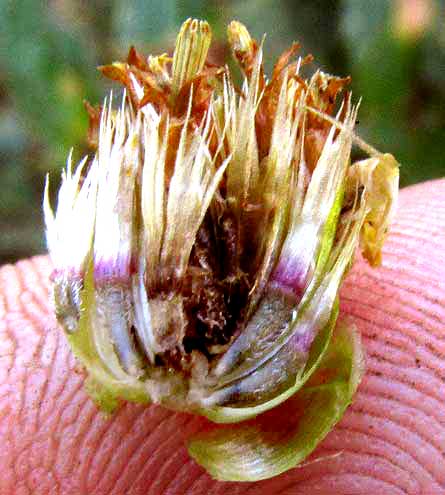
Notice the dried-up disc flower corollas and anther tubes that aren't falling off (marcescent). More important for identification purposes is the white pappus atop each grain-like, cypsela-type fruit. The pappus segments are not slender hairs but rather long, slender, sharp-pointed scales, purple at their bases, and seeming to unite at their bases where they attach to the cypselae. Each individual cypsela is separated by its neighbor by a pale, papery, scoop-shaped scale, a palea. And the cypselae themselves are a little angular in shape but don't display wings or sharp edges.
Though this Yucatan species may not be included in the online Flora of North America, there's no treatment for the Aster Family of the Yucatan, so I tried keying out our plant in the Flora of North America. I came up with the name LASIANTHAEA FRUTICOSA (*see sidebar), with no good English name, a species occurring throughout central and southern Mexico southward throughout Central America. The genus Lasianthaea is one I'd never heard of, embracing eleven species. Mexico appears to be its center of evolution.
Good pictures of details of the species aren't available on the Internet, so I'm just not sure about this ID. We'll park this page and hope an expert will come along to help.
from the March 8, 2019 Newsletter issued from Rancho Regenesis in the woods ±4kms west of Ek Balam Ruins; elevation ~40m (~130 ft), N20.876°, W88.170°; north-central Yucatán, MÉXICO
LASIANTHAEA?
A month ago at the weedy edge of the abandoned papaya field below the hut a chest-high member of the enormous Composite or Aster Family, the Asteraceae, was prettily flowering with yellow blossoms. It seemed to be the same species profiled above, whose identification is uncertain. However, with this plant I was able to get better pictures. First, the plant itself:
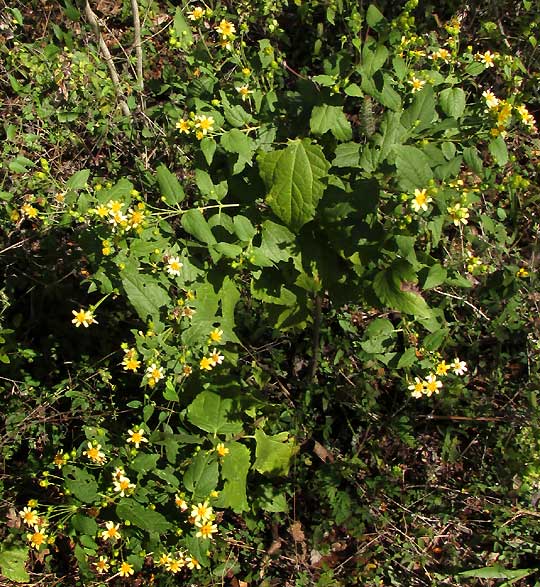
The composite flower clusters were a little unusual in that the crammed-together, cylindrical disc flowers forming the flower heads' eyes were bright yellow, while the petal-like ray flowers along the heads' margins were somewhat paler, as shown below:

Another slightly unusual feature was that each flowering head arose at the tip of an exceptionally long stem, or peduncle, more easily seen in clusters where the heads already have lost their ray flower corollas, as seen below:

A close-up of a composite head appears below:

In that picture notice how each ray flower is "pleated" lengthwise, and that ray-flower corolla tips are indented so that a middle "tooth" is a little shorter than the teeth beside it. In the eye's center, the disc flowers' corollas bear lobes that are unusually long, sharp pointed, and backward curving. The greenish involucres subtending the heads were formed of unusual bracts, most noticeable on older heads, as seen below:

The bracts, overlapping one another in three or four series, are uncommonly broad and rounded at their tips, instead of being of the usual narrow, long, sharp-tipped type. Also, the bracts are strangely smooth and shiny, with gland-like swellings below their tips. Breaking open a maturing head, we see what's shown below:

Important to notice here is that papery "paleae" almost completely, but not entirely wrap around the dark, short-hairy, cypsela-type fruits, and that atop the cypselae there are long, slender, stiff scales or bristles forming "pappuses." Once the fruits mature, the dried-up involucre below each head opens broadly, releasing the cypselae, whose pappus scales now have enlarged and spread apart forming conspicuous star-like "parachutes" useful for wind dissemination, as seen below:

The spreading pappus scales atop their dark cypselae are better shown below:
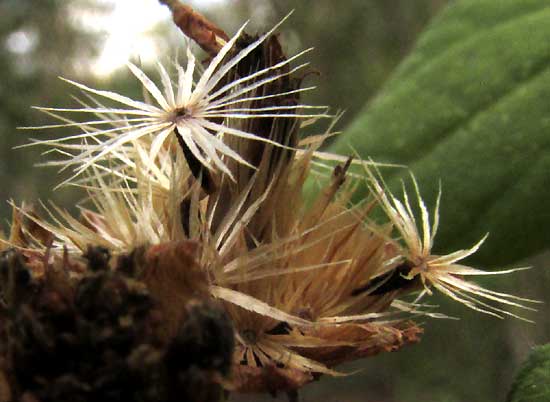
And the hairy mature cypselae ready to fly are shown below:
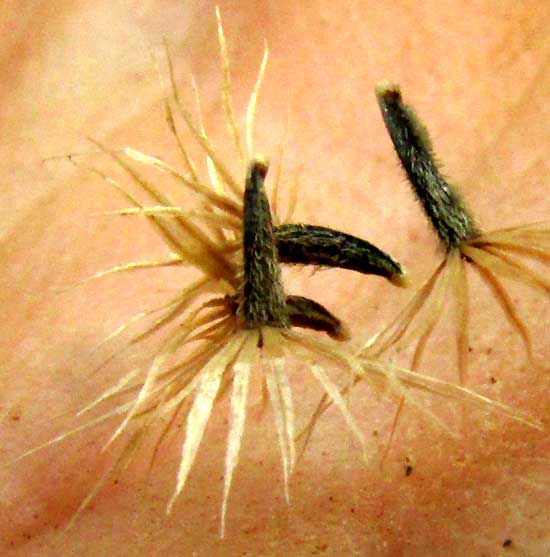
With all these excellent field marks noticed, I'm still not sure of this plant's identity. It seems to be the same as the plant documented above, close to Lasianthaea macrocephala, but that species isn't well represented on the Internet, and I just don't know if that's what we have. This is just one of those time when I'm parking pictures here, hoping an expert will come along to help out.